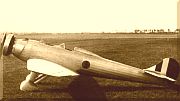| Fiat BRG | |
|---|---|
 | |
| Role | Heavy bomber |
| Manufacturer | Fiat |
| First flight | 1930s |
| Primary user | Italian Air Force |
| Number built | 1 |
The Fiat BRG was an Italian heavy bomber prototype built in the 1930s by Fiat for the Italian Air Force.
| Fiat BRG | |
|---|---|
 | |
| Role | Heavy bomber |
| Manufacturer | Fiat |
| First flight | 1930s |
| Primary user | Italian Air Force |
| Number built | 1 |
The Fiat BRG was an Italian heavy bomber prototype built in the 1930s by Fiat for the Italian Air Force.
The BRG (Bombardiere Rosatelli Gigante, "Giant Rosatelli Bomber") was a three-engine strut-braced high-wing monoplane. It had a deep slab-sided fuselage with one engine in the nose and two strut-mounted engines between the upper wing and a short stub wing attached to the lower fuselage. The BRG had a single fin and rudder and a wide-track landing gear. The pilot and co-pilot had a cabin forward of the wing leading edge. The aircraft was fitted with four machine guns, located in an open dorsal cockpit and a ventral tunnel. After testing in 1931 the prototype BRG was attached to 62 Squadriglia SPB, an experimental heavy bomber squadron.

Data fromThe Illustrated Encyclopedia of Aircraft (Part Work 1982-1985), 1985, Orbis Publishing, Page 1780
General characteristics
Performance
Armament

The Friedrichshafen G.I was a prototype heavy bomber aircraft that was built in Germany by Flugzeugbau Friedrichshafen in 1915. It was Karl Gehlen's first design for the company, and although it was not produced in quantity, it provided the foundation for the later, highly successful bombers culminating in the G.III.

The Comte AC-3 was a 1920s Swiss bomber/transport aircraft produced by Flugzeugbau A. Comte.

The Fiat RS.14 was an Italian long-range maritime strategic reconnaissance floatplane. The RS.14 was a four/five seat all-metal cantilever low/mid-wing monoplane powered by two wing-mounted 626 kW (840 hp) Fiat A.74 R.C.38 engines. It had a conventional cantilever tail unit with a single fin and rudder. Its undercarriage consisted of two large floats on struts. It had a glazed nose for an observer or bomb aimer. The pilot and copilot sat side by side with a wireless operator's compartment behind them. In the bombing role the RS.14 was fitted with a long ventral gondola to carry various combinations of anti-submarine bombs.

The Farman F.50 was a French twin-engined night bomber designed and built by Farman as a replacement for the single-engined Voisin pusher biplanes in service with the French Air Force.

The Fiat CR.30 was a 1930s Italian single-seat biplane fighter aircraft designed by Celestino Rosatelli and built by Fiat.

The Fiat G.2 was an Italian three-engine six-passenger monoplane transport aircraft designed by Giuseppe Gabrielli and built by Fiat.

The Fiat G.49 was an Italian two-seat basic trainer designed by Giuseppe Gabrielli and built by Fiat.

The Fiat B.R. 1/4 was a light bomber series, developed in Italy shortly after World War I.

The Savoia-Marchetti S.66 was a 1930s Italian twin-hull flying boat designed and built by Savoia-Marchetti as an enlarged development of the S.55.

The Sopwith Admiralty Type 860 was a 1910s British biplane seaplane torpedo bomber designed and built for the Admiralty by the Sopwith Aviation Company.

The Potez 32 and its military version the Potez 33 was a single-engine French monoplane transport built by Potez and based on the Potez 29 biplane.

The Boeing AT-15 was an American twin-engined bomber crew trainer designed and built by Boeing's Wichita Division. Only two prototypes, designated XAT-15, were built. Plans to build over 1,000 were cancelled on the United States' entry into the Second World War.
The Farman B.2 was a 1920s French biplane designed as a light day bomber. Only one was built.

The Fokker D.XXIII was a Dutch single-seat fighter designed and built by Fokker. Only one aircraft was flown before the country was invaded by the Germans in May 1940.

The Fiat BGA was an aircraft designed by Aldo Guglielmetti of the Italian Air Force.

The Fiat G.5 was an Italian two-seat aerobatic tourer or trainer designed and built by Fiat Aviazione in small numbers.

The Caproni Ca.90 was a prototype Italian heavy bomber designed and built by Caproni. When it first flew in 1929 it was the largest land-based aircraft in the world.

The Hanriot H.35 was a 1920s French intermediate training monoplane designed and built by Avions Hanriot.

The Powell P-70 Acey Deucy is an American two-seat parasol wing monoplane designed and built by John C. Powell for amateur construction.
The Gerin Varivol was a 1930s French research aircraft designed and built by Jacques Gerin. Only one aircraft was flown during 1936 before it was destroyed in an accident.